Mental Health Nursing Report: A Case Study of Schizophrenia Treatment
VerifiedAdded on 2022/12/26
|12
|3358
|34
Report
AI Summary
This report provides a comprehensive analysis of schizophrenia from a mental health nursing perspective, drawing insights from the movie "A Beautiful Mind." It begins by exploring the development of the illness, including the onset of symptoms and the challenges of diagnosis, differentiating schizophrenia from bipolar disorder. The report then examines the legal and ethical considerations surrounding the Mental Health Act and its application in the context of the case study, highlighting issues of involuntary hospitalization and treatment approaches. Furthermore, it discusses alternative treatment approaches, such as medication, therapy, yoga and meditation, and the importance of early intervention strategies in managing schizophrenia. Finally, the report delves into the depiction of recovery and the impact of early intervention, offering a detailed overview of the complexities of the illness and its management.

0
Running Head: Mental Health- Nursing
MENTAL HEALTH- NURSING
Running Head: Mental Health- Nursing
MENTAL HEALTH- NURSING
Paraphrase This Document
Need a fresh take? Get an instant paraphrase of this document with our AI Paraphraser
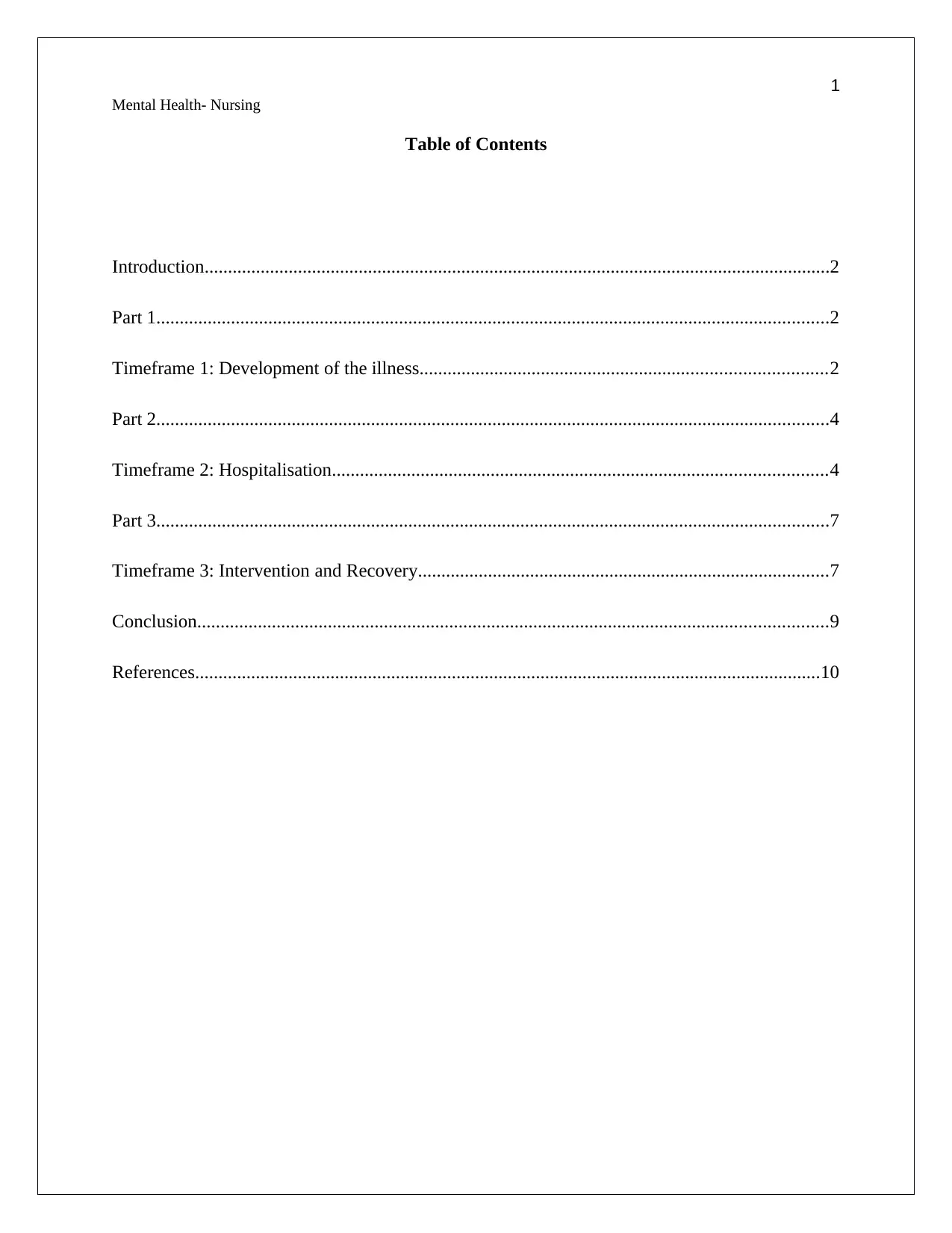
1
Mental Health- Nursing
Table of Contents
Introduction......................................................................................................................................2
Part 1................................................................................................................................................2
Timeframe 1: Development of the illness.......................................................................................2
Part 2................................................................................................................................................4
Timeframe 2: Hospitalisation..........................................................................................................4
Part 3................................................................................................................................................7
Timeframe 3: Intervention and Recovery........................................................................................7
Conclusion.......................................................................................................................................9
References......................................................................................................................................10
Mental Health- Nursing
Table of Contents
Introduction......................................................................................................................................2
Part 1................................................................................................................................................2
Timeframe 1: Development of the illness.......................................................................................2
Part 2................................................................................................................................................4
Timeframe 2: Hospitalisation..........................................................................................................4
Part 3................................................................................................................................................7
Timeframe 3: Intervention and Recovery........................................................................................7
Conclusion.......................................................................................................................................9
References......................................................................................................................................10
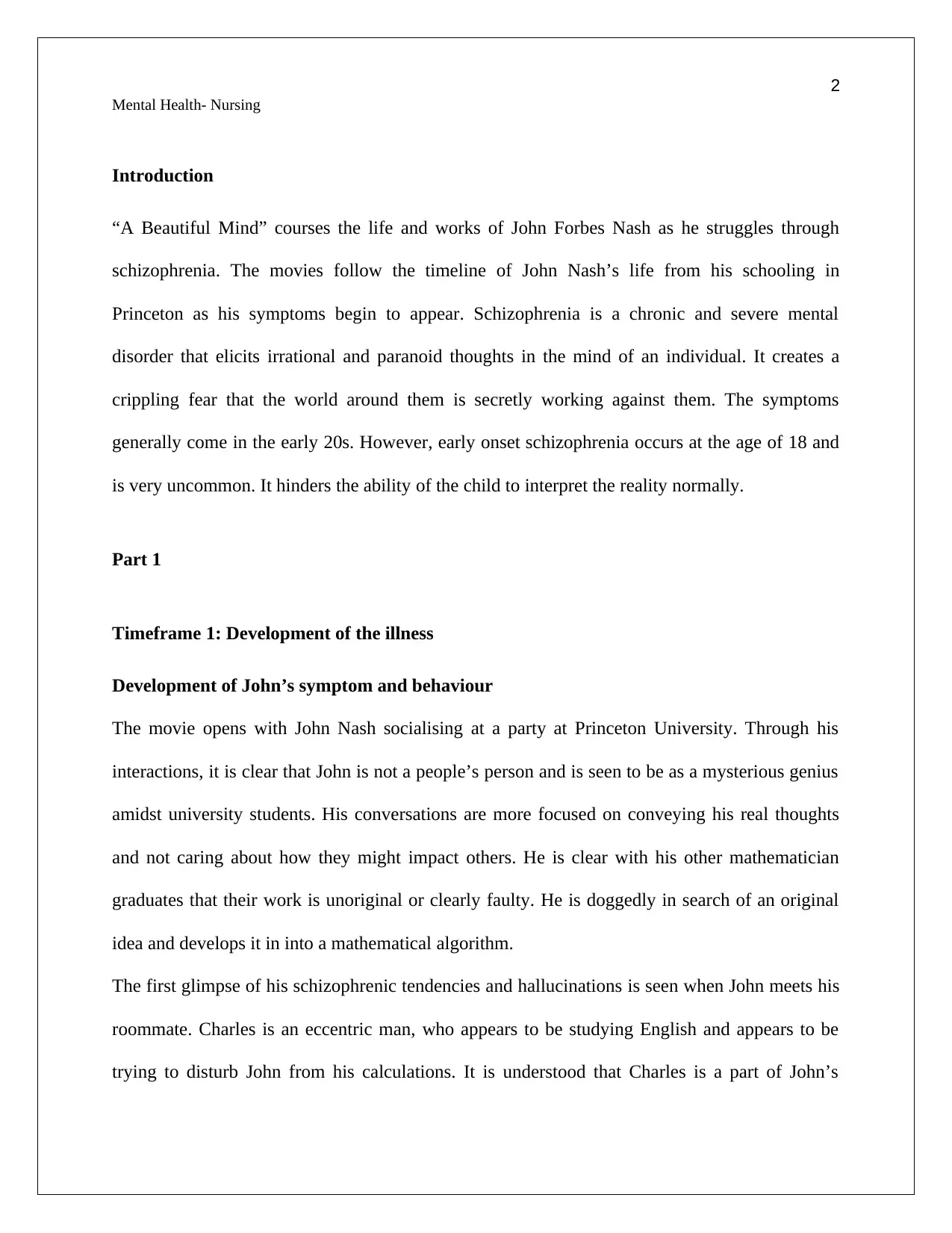
2
Mental Health- Nursing
Introduction
“A Beautiful Mind” courses the life and works of John Forbes Nash as he struggles through
schizophrenia. The movies follow the timeline of John Nash’s life from his schooling in
Princeton as his symptoms begin to appear. Schizophrenia is a chronic and severe mental
disorder that elicits irrational and paranoid thoughts in the mind of an individual. It creates a
crippling fear that the world around them is secretly working against them. The symptoms
generally come in the early 20s. However, early onset schizophrenia occurs at the age of 18 and
is very uncommon. It hinders the ability of the child to interpret the reality normally.
Part 1
Timeframe 1: Development of the illness
Development of John’s symptom and behaviour
The movie opens with John Nash socialising at a party at Princeton University. Through his
interactions, it is clear that John is not a people’s person and is seen to be as a mysterious genius
amidst university students. His conversations are more focused on conveying his real thoughts
and not caring about how they might impact others. He is clear with his other mathematician
graduates that their work is unoriginal or clearly faulty. He is doggedly in search of an original
idea and develops it in into a mathematical algorithm.
The first glimpse of his schizophrenic tendencies and hallucinations is seen when John meets his
roommate. Charles is an eccentric man, who appears to be studying English and appears to be
trying to disturb John from his calculations. It is understood that Charles is a part of John’s
Mental Health- Nursing
Introduction
“A Beautiful Mind” courses the life and works of John Forbes Nash as he struggles through
schizophrenia. The movies follow the timeline of John Nash’s life from his schooling in
Princeton as his symptoms begin to appear. Schizophrenia is a chronic and severe mental
disorder that elicits irrational and paranoid thoughts in the mind of an individual. It creates a
crippling fear that the world around them is secretly working against them. The symptoms
generally come in the early 20s. However, early onset schizophrenia occurs at the age of 18 and
is very uncommon. It hinders the ability of the child to interpret the reality normally.
Part 1
Timeframe 1: Development of the illness
Development of John’s symptom and behaviour
The movie opens with John Nash socialising at a party at Princeton University. Through his
interactions, it is clear that John is not a people’s person and is seen to be as a mysterious genius
amidst university students. His conversations are more focused on conveying his real thoughts
and not caring about how they might impact others. He is clear with his other mathematician
graduates that their work is unoriginal or clearly faulty. He is doggedly in search of an original
idea and develops it in into a mathematical algorithm.
The first glimpse of his schizophrenic tendencies and hallucinations is seen when John meets his
roommate. Charles is an eccentric man, who appears to be studying English and appears to be
trying to disturb John from his calculations. It is understood that Charles is a part of John’s
⊘ This is a preview!⊘
Do you want full access?
Subscribe today to unlock all pages.

Trusted by 1+ million students worldwide

3
Mental Health- Nursing
hallucinations as the room is clearly built for one person and cannot home another roommate
(Yang et al. 2015).
Diagnosis of schizophrenia
His hallucination episodes are discovered at their peak when he is giving a speech about his
mathematical discovery. He sees men in suit and thinks of them to be spies from the soviet union
who have come to capture him. He dashes from the stage in order to escape from them and is
chased by them. It later becomes clear that those men are actually from a mental institution
trying to get him admitted to a psychiatric institution (Green, 2018).
His hallucinations have created a separate world for him where he believes to be involved in a
secret mission for the Department of Defense against the Soviet Union. He has been diligently
working on breaking a code and delivering the research through letters, posting them in a
mailbox. It is later proved that the letters remained unopened where he left them (Geretsegger et
al. 2017).
It is difficult to clearly understand how he was diagnosed, as the movie is being depicted from
John’s point of view and is not a reliable source for the narrative. This is because John’s
muddled mind is not able to follow along with reality and is spent in his pursuit of finding the
code.
Differentiating symptoms of schizophrenia from the symptoms of bipolar disorder
Bipolar disorder causes a strong shift in the mood and behaviour of an individual. This makes
them able to switch between extreme emotions within the fraction of seconds. It is sometimes
followed with hallucination episodes where the individual believes to be seeing things that do not
actually happen.
Mental Health- Nursing
hallucinations as the room is clearly built for one person and cannot home another roommate
(Yang et al. 2015).
Diagnosis of schizophrenia
His hallucination episodes are discovered at their peak when he is giving a speech about his
mathematical discovery. He sees men in suit and thinks of them to be spies from the soviet union
who have come to capture him. He dashes from the stage in order to escape from them and is
chased by them. It later becomes clear that those men are actually from a mental institution
trying to get him admitted to a psychiatric institution (Green, 2018).
His hallucinations have created a separate world for him where he believes to be involved in a
secret mission for the Department of Defense against the Soviet Union. He has been diligently
working on breaking a code and delivering the research through letters, posting them in a
mailbox. It is later proved that the letters remained unopened where he left them (Geretsegger et
al. 2017).
It is difficult to clearly understand how he was diagnosed, as the movie is being depicted from
John’s point of view and is not a reliable source for the narrative. This is because John’s
muddled mind is not able to follow along with reality and is spent in his pursuit of finding the
code.
Differentiating symptoms of schizophrenia from the symptoms of bipolar disorder
Bipolar disorder causes a strong shift in the mood and behaviour of an individual. This makes
them able to switch between extreme emotions within the fraction of seconds. It is sometimes
followed with hallucination episodes where the individual believes to be seeing things that do not
actually happen.
Paraphrase This Document
Need a fresh take? Get an instant paraphrase of this document with our AI Paraphraser
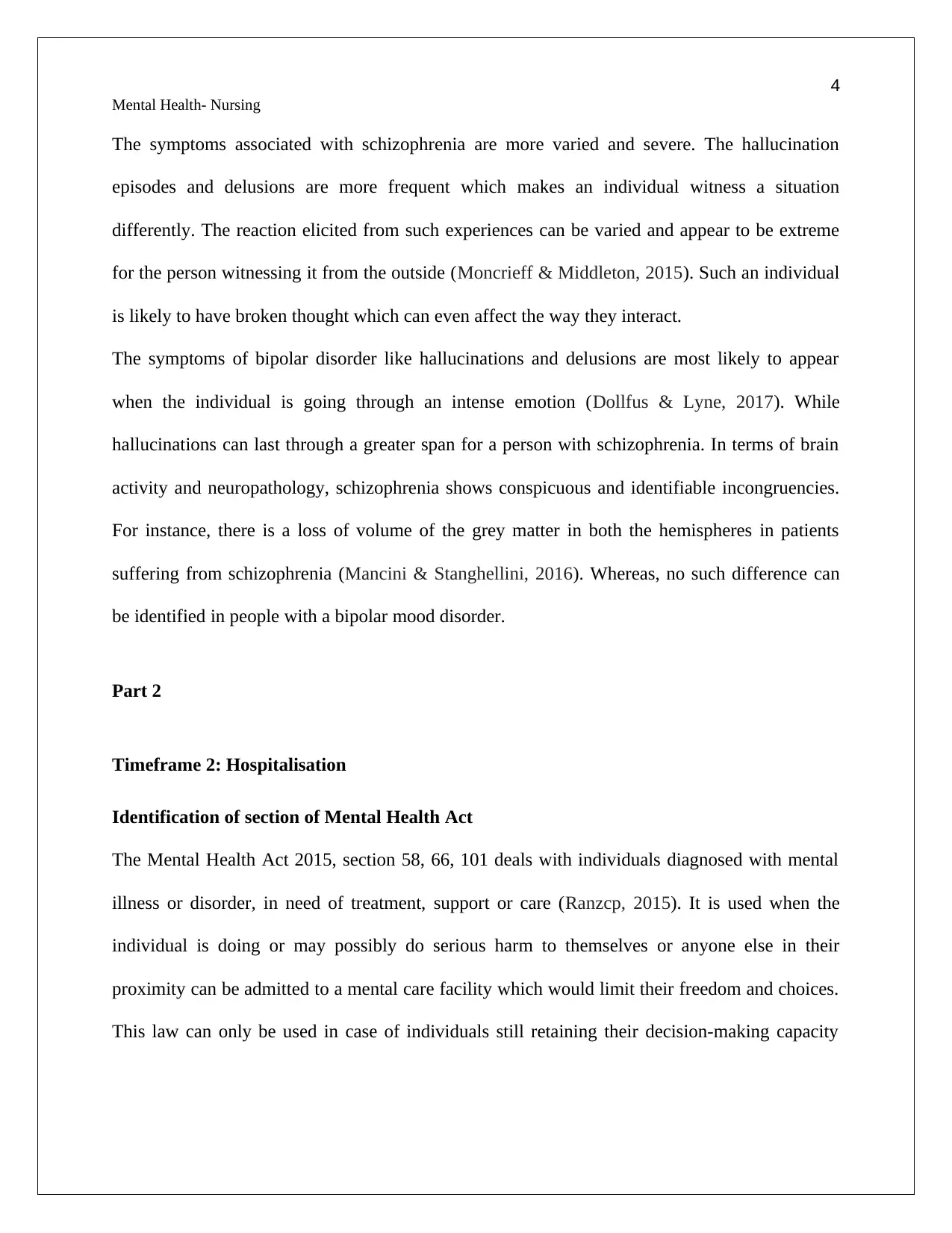
4
Mental Health- Nursing
The symptoms associated with schizophrenia are more varied and severe. The hallucination
episodes and delusions are more frequent which makes an individual witness a situation
differently. The reaction elicited from such experiences can be varied and appear to be extreme
for the person witnessing it from the outside (Moncrieff & Middleton, 2015). Such an individual
is likely to have broken thought which can even affect the way they interact.
The symptoms of bipolar disorder like hallucinations and delusions are most likely to appear
when the individual is going through an intense emotion (Dollfus & Lyne, 2017). While
hallucinations can last through a greater span for a person with schizophrenia. In terms of brain
activity and neuropathology, schizophrenia shows conspicuous and identifiable incongruencies.
For instance, there is a loss of volume of the grey matter in both the hemispheres in patients
suffering from schizophrenia (Mancini & Stanghellini, 2016). Whereas, no such difference can
be identified in people with a bipolar mood disorder.
Part 2
Timeframe 2: Hospitalisation
Identification of section of Mental Health Act
The Mental Health Act 2015, section 58, 66, 101 deals with individuals diagnosed with mental
illness or disorder, in need of treatment, support or care (Ranzcp, 2015). It is used when the
individual is doing or may possibly do serious harm to themselves or anyone else in their
proximity can be admitted to a mental care facility which would limit their freedom and choices.
This law can only be used in case of individuals still retaining their decision-making capacity
Mental Health- Nursing
The symptoms associated with schizophrenia are more varied and severe. The hallucination
episodes and delusions are more frequent which makes an individual witness a situation
differently. The reaction elicited from such experiences can be varied and appear to be extreme
for the person witnessing it from the outside (Moncrieff & Middleton, 2015). Such an individual
is likely to have broken thought which can even affect the way they interact.
The symptoms of bipolar disorder like hallucinations and delusions are most likely to appear
when the individual is going through an intense emotion (Dollfus & Lyne, 2017). While
hallucinations can last through a greater span for a person with schizophrenia. In terms of brain
activity and neuropathology, schizophrenia shows conspicuous and identifiable incongruencies.
For instance, there is a loss of volume of the grey matter in both the hemispheres in patients
suffering from schizophrenia (Mancini & Stanghellini, 2016). Whereas, no such difference can
be identified in people with a bipolar mood disorder.
Part 2
Timeframe 2: Hospitalisation
Identification of section of Mental Health Act
The Mental Health Act 2015, section 58, 66, 101 deals with individuals diagnosed with mental
illness or disorder, in need of treatment, support or care (Ranzcp, 2015). It is used when the
individual is doing or may possibly do serious harm to themselves or anyone else in their
proximity can be admitted to a mental care facility which would limit their freedom and choices.
This law can only be used in case of individuals still retaining their decision-making capacity

5
Mental Health- Nursing
and are refusing care only when the treatment will be able to safeguard them and other people
from severe harm and health deterioration.
Discussion of the Mental Health Act
The law is meant when involuntary hospitalisation or support needs to be provided for
safeguarding the health and wellbeing of an individual diagnosed with mental illness (Ranzcp,
2015). However, the act cannot be used if any other form of care is available that will not require
limiting the freedom and decision-making ability of the individual (Chyzhyk, Savio & Graña,
2015). It is necessary to ensure that the threat of harm to the individual and the people around
them is serious in order to override the decision making the ability of the individual. The law has
minor changes depending upon the jurisdiction. The New Zealand court’s criteria are broader
and may allow people with diminished capacity to take of themselves. In a way, they are more
focused towards the free will than the health and wellbeing of a person.
Use in John’s treatment
From the portrayal and narration of the movie it is difficult to understand whether the Mental
Health Law or any such kind of legal protection was provided to John or not (Koutsouleris et al.
2015). It is only presented that he dragged to the hospital, quite unwillingly. His wife acted as his
guardian who must have been consulted and may have given permission in place of John. It can
only be said that in the period where the movie is said, the idea of free will and its significance in
medical care may not have been realised to the fullest. However, John’s wife, Alicia makes an
attempt to prove it to him that his attempt at solving the code is a part of his hallucinations and
that William Parcher is just a figment of his mind. This can be considered as an attempt to make
John aware of his condition and be more willing to accept treatment.
Legal and ethical issues in John’s treatment
Mental Health- Nursing
and are refusing care only when the treatment will be able to safeguard them and other people
from severe harm and health deterioration.
Discussion of the Mental Health Act
The law is meant when involuntary hospitalisation or support needs to be provided for
safeguarding the health and wellbeing of an individual diagnosed with mental illness (Ranzcp,
2015). However, the act cannot be used if any other form of care is available that will not require
limiting the freedom and decision-making ability of the individual (Chyzhyk, Savio & Graña,
2015). It is necessary to ensure that the threat of harm to the individual and the people around
them is serious in order to override the decision making the ability of the individual. The law has
minor changes depending upon the jurisdiction. The New Zealand court’s criteria are broader
and may allow people with diminished capacity to take of themselves. In a way, they are more
focused towards the free will than the health and wellbeing of a person.
Use in John’s treatment
From the portrayal and narration of the movie it is difficult to understand whether the Mental
Health Law or any such kind of legal protection was provided to John or not (Koutsouleris et al.
2015). It is only presented that he dragged to the hospital, quite unwillingly. His wife acted as his
guardian who must have been consulted and may have given permission in place of John. It can
only be said that in the period where the movie is said, the idea of free will and its significance in
medical care may not have been realised to the fullest. However, John’s wife, Alicia makes an
attempt to prove it to him that his attempt at solving the code is a part of his hallucinations and
that William Parcher is just a figment of his mind. This can be considered as an attempt to make
John aware of his condition and be more willing to accept treatment.
Legal and ethical issues in John’s treatment
⊘ This is a preview!⊘
Do you want full access?
Subscribe today to unlock all pages.

Trusted by 1+ million students worldwide
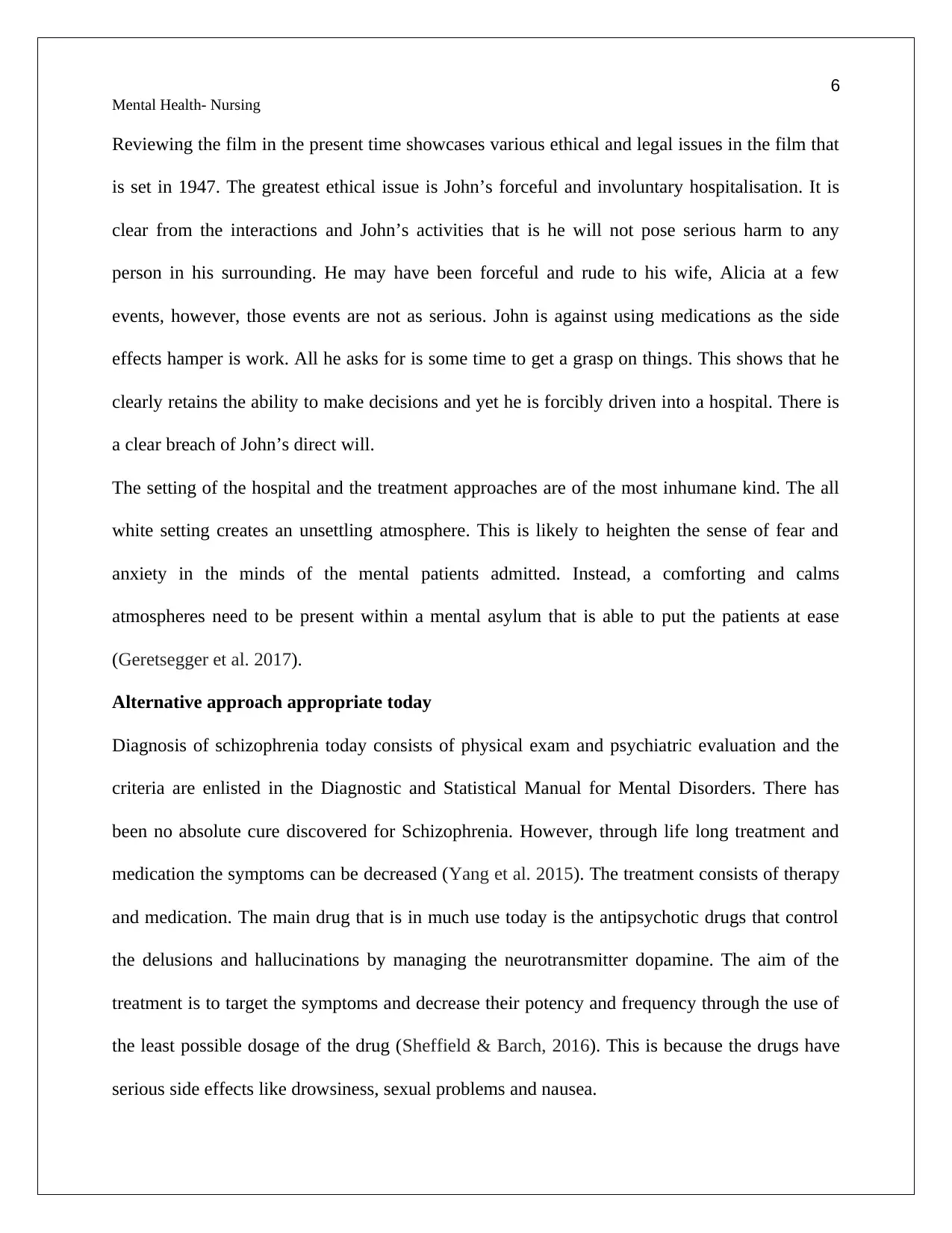
6
Mental Health- Nursing
Reviewing the film in the present time showcases various ethical and legal issues in the film that
is set in 1947. The greatest ethical issue is John’s forceful and involuntary hospitalisation. It is
clear from the interactions and John’s activities that is he will not pose serious harm to any
person in his surrounding. He may have been forceful and rude to his wife, Alicia at a few
events, however, those events are not as serious. John is against using medications as the side
effects hamper is work. All he asks for is some time to get a grasp on things. This shows that he
clearly retains the ability to make decisions and yet he is forcibly driven into a hospital. There is
a clear breach of John’s direct will.
The setting of the hospital and the treatment approaches are of the most inhumane kind. The all
white setting creates an unsettling atmosphere. This is likely to heighten the sense of fear and
anxiety in the minds of the mental patients admitted. Instead, a comforting and calms
atmospheres need to be present within a mental asylum that is able to put the patients at ease
(Geretsegger et al. 2017).
Alternative approach appropriate today
Diagnosis of schizophrenia today consists of physical exam and psychiatric evaluation and the
criteria are enlisted in the Diagnostic and Statistical Manual for Mental Disorders. There has
been no absolute cure discovered for Schizophrenia. However, through life long treatment and
medication the symptoms can be decreased (Yang et al. 2015). The treatment consists of therapy
and medication. The main drug that is in much use today is the antipsychotic drugs that control
the delusions and hallucinations by managing the neurotransmitter dopamine. The aim of the
treatment is to target the symptoms and decrease their potency and frequency through the use of
the least possible dosage of the drug (Sheffield & Barch, 2016). This is because the drugs have
serious side effects like drowsiness, sexual problems and nausea.
Mental Health- Nursing
Reviewing the film in the present time showcases various ethical and legal issues in the film that
is set in 1947. The greatest ethical issue is John’s forceful and involuntary hospitalisation. It is
clear from the interactions and John’s activities that is he will not pose serious harm to any
person in his surrounding. He may have been forceful and rude to his wife, Alicia at a few
events, however, those events are not as serious. John is against using medications as the side
effects hamper is work. All he asks for is some time to get a grasp on things. This shows that he
clearly retains the ability to make decisions and yet he is forcibly driven into a hospital. There is
a clear breach of John’s direct will.
The setting of the hospital and the treatment approaches are of the most inhumane kind. The all
white setting creates an unsettling atmosphere. This is likely to heighten the sense of fear and
anxiety in the minds of the mental patients admitted. Instead, a comforting and calms
atmospheres need to be present within a mental asylum that is able to put the patients at ease
(Geretsegger et al. 2017).
Alternative approach appropriate today
Diagnosis of schizophrenia today consists of physical exam and psychiatric evaluation and the
criteria are enlisted in the Diagnostic and Statistical Manual for Mental Disorders. There has
been no absolute cure discovered for Schizophrenia. However, through life long treatment and
medication the symptoms can be decreased (Yang et al. 2015). The treatment consists of therapy
and medication. The main drug that is in much use today is the antipsychotic drugs that control
the delusions and hallucinations by managing the neurotransmitter dopamine. The aim of the
treatment is to target the symptoms and decrease their potency and frequency through the use of
the least possible dosage of the drug (Sheffield & Barch, 2016). This is because the drugs have
serious side effects like drowsiness, sexual problems and nausea.
Paraphrase This Document
Need a fresh take? Get an instant paraphrase of this document with our AI Paraphraser
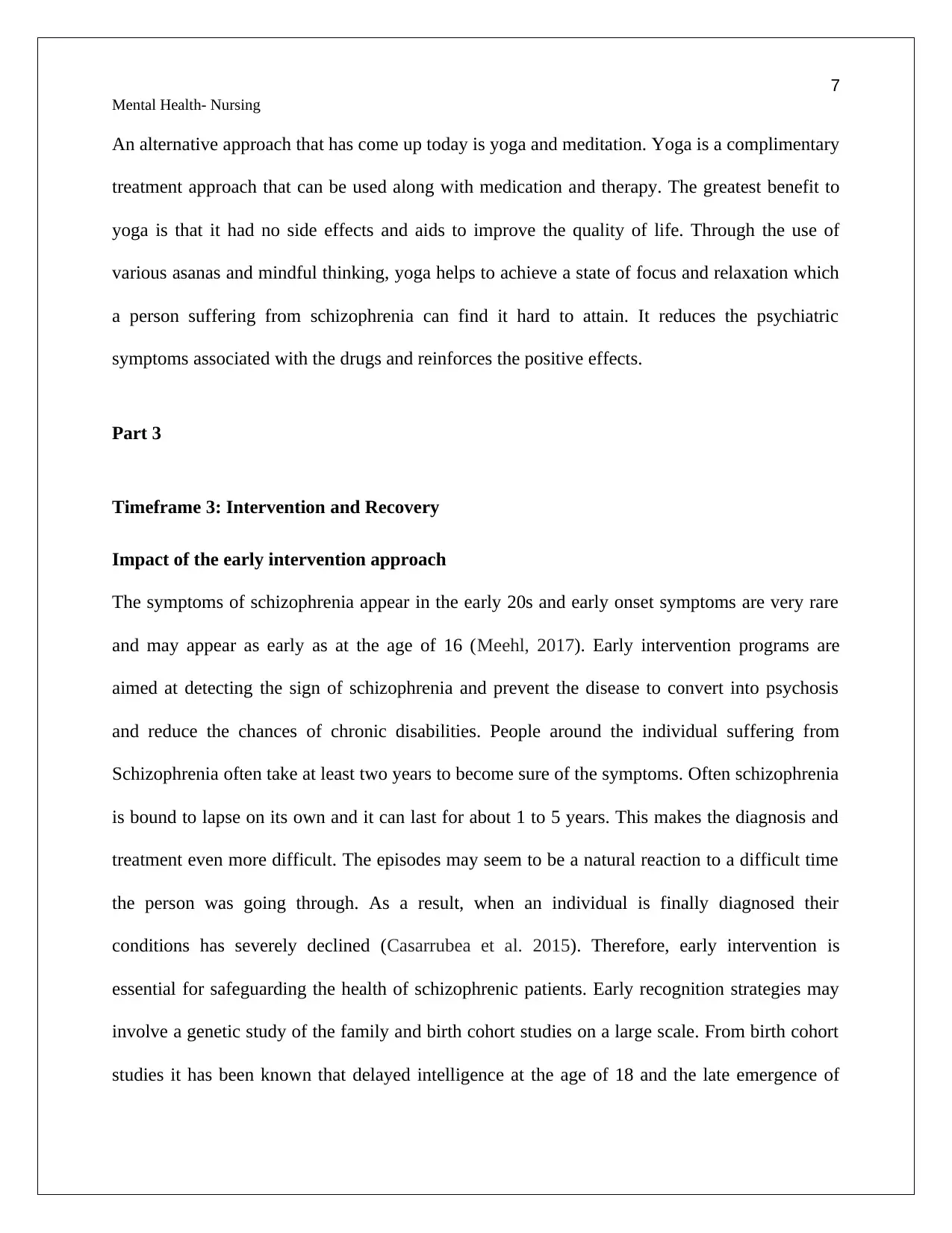
7
Mental Health- Nursing
An alternative approach that has come up today is yoga and meditation. Yoga is a complimentary
treatment approach that can be used along with medication and therapy. The greatest benefit to
yoga is that it had no side effects and aids to improve the quality of life. Through the use of
various asanas and mindful thinking, yoga helps to achieve a state of focus and relaxation which
a person suffering from schizophrenia can find it hard to attain. It reduces the psychiatric
symptoms associated with the drugs and reinforces the positive effects.
Part 3
Timeframe 3: Intervention and Recovery
Impact of the early intervention approach
The symptoms of schizophrenia appear in the early 20s and early onset symptoms are very rare
and may appear as early as at the age of 16 (Meehl, 2017). Early intervention programs are
aimed at detecting the sign of schizophrenia and prevent the disease to convert into psychosis
and reduce the chances of chronic disabilities. People around the individual suffering from
Schizophrenia often take at least two years to become sure of the symptoms. Often schizophrenia
is bound to lapse on its own and it can last for about 1 to 5 years. This makes the diagnosis and
treatment even more difficult. The episodes may seem to be a natural reaction to a difficult time
the person was going through. As a result, when an individual is finally diagnosed their
conditions has severely declined (Casarrubea et al. 2015). Therefore, early intervention is
essential for safeguarding the health of schizophrenic patients. Early recognition strategies may
involve a genetic study of the family and birth cohort studies on a large scale. From birth cohort
studies it has been known that delayed intelligence at the age of 18 and the late emergence of
Mental Health- Nursing
An alternative approach that has come up today is yoga and meditation. Yoga is a complimentary
treatment approach that can be used along with medication and therapy. The greatest benefit to
yoga is that it had no side effects and aids to improve the quality of life. Through the use of
various asanas and mindful thinking, yoga helps to achieve a state of focus and relaxation which
a person suffering from schizophrenia can find it hard to attain. It reduces the psychiatric
symptoms associated with the drugs and reinforces the positive effects.
Part 3
Timeframe 3: Intervention and Recovery
Impact of the early intervention approach
The symptoms of schizophrenia appear in the early 20s and early onset symptoms are very rare
and may appear as early as at the age of 16 (Meehl, 2017). Early intervention programs are
aimed at detecting the sign of schizophrenia and prevent the disease to convert into psychosis
and reduce the chances of chronic disabilities. People around the individual suffering from
Schizophrenia often take at least two years to become sure of the symptoms. Often schizophrenia
is bound to lapse on its own and it can last for about 1 to 5 years. This makes the diagnosis and
treatment even more difficult. The episodes may seem to be a natural reaction to a difficult time
the person was going through. As a result, when an individual is finally diagnosed their
conditions has severely declined (Casarrubea et al. 2015). Therefore, early intervention is
essential for safeguarding the health of schizophrenic patients. Early recognition strategies may
involve a genetic study of the family and birth cohort studies on a large scale. From birth cohort
studies it has been known that delayed intelligence at the age of 18 and the late emergence of
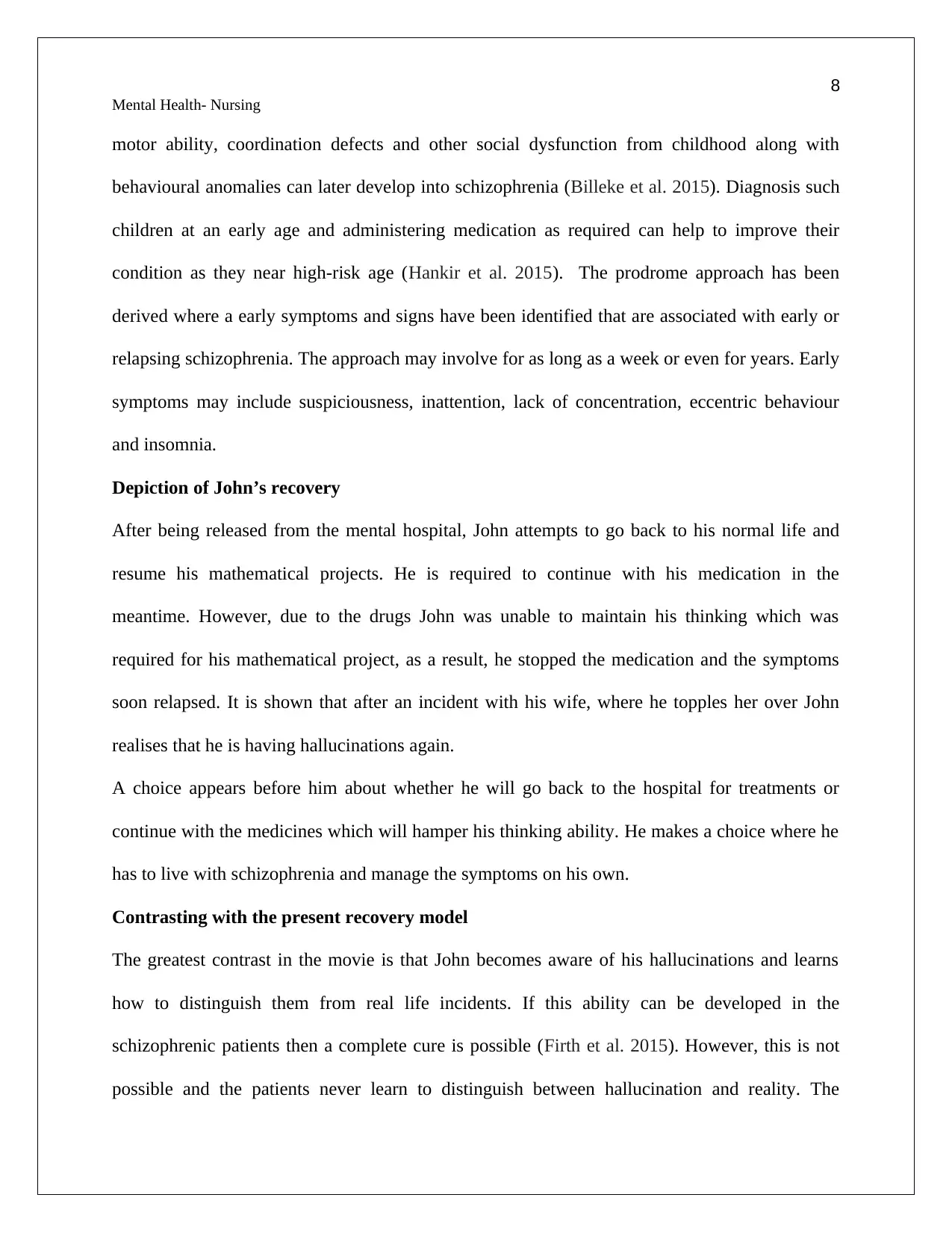
8
Mental Health- Nursing
motor ability, coordination defects and other social dysfunction from childhood along with
behavioural anomalies can later develop into schizophrenia (Billeke et al. 2015). Diagnosis such
children at an early age and administering medication as required can help to improve their
condition as they near high-risk age (Hankir et al. 2015). The prodrome approach has been
derived where a early symptoms and signs have been identified that are associated with early or
relapsing schizophrenia. The approach may involve for as long as a week or even for years. Early
symptoms may include suspiciousness, inattention, lack of concentration, eccentric behaviour
and insomnia.
Depiction of John’s recovery
After being released from the mental hospital, John attempts to go back to his normal life and
resume his mathematical projects. He is required to continue with his medication in the
meantime. However, due to the drugs John was unable to maintain his thinking which was
required for his mathematical project, as a result, he stopped the medication and the symptoms
soon relapsed. It is shown that after an incident with his wife, where he topples her over John
realises that he is having hallucinations again.
A choice appears before him about whether he will go back to the hospital for treatments or
continue with the medicines which will hamper his thinking ability. He makes a choice where he
has to live with schizophrenia and manage the symptoms on his own.
Contrasting with the present recovery model
The greatest contrast in the movie is that John becomes aware of his hallucinations and learns
how to distinguish them from real life incidents. If this ability can be developed in the
schizophrenic patients then a complete cure is possible (Firth et al. 2015). However, this is not
possible and the patients never learn to distinguish between hallucination and reality. The
Mental Health- Nursing
motor ability, coordination defects and other social dysfunction from childhood along with
behavioural anomalies can later develop into schizophrenia (Billeke et al. 2015). Diagnosis such
children at an early age and administering medication as required can help to improve their
condition as they near high-risk age (Hankir et al. 2015). The prodrome approach has been
derived where a early symptoms and signs have been identified that are associated with early or
relapsing schizophrenia. The approach may involve for as long as a week or even for years. Early
symptoms may include suspiciousness, inattention, lack of concentration, eccentric behaviour
and insomnia.
Depiction of John’s recovery
After being released from the mental hospital, John attempts to go back to his normal life and
resume his mathematical projects. He is required to continue with his medication in the
meantime. However, due to the drugs John was unable to maintain his thinking which was
required for his mathematical project, as a result, he stopped the medication and the symptoms
soon relapsed. It is shown that after an incident with his wife, where he topples her over John
realises that he is having hallucinations again.
A choice appears before him about whether he will go back to the hospital for treatments or
continue with the medicines which will hamper his thinking ability. He makes a choice where he
has to live with schizophrenia and manage the symptoms on his own.
Contrasting with the present recovery model
The greatest contrast in the movie is that John becomes aware of his hallucinations and learns
how to distinguish them from real life incidents. If this ability can be developed in the
schizophrenic patients then a complete cure is possible (Firth et al. 2015). However, this is not
possible and the patients never learn to distinguish between hallucination and reality. The
⊘ This is a preview!⊘
Do you want full access?
Subscribe today to unlock all pages.

Trusted by 1+ million students worldwide
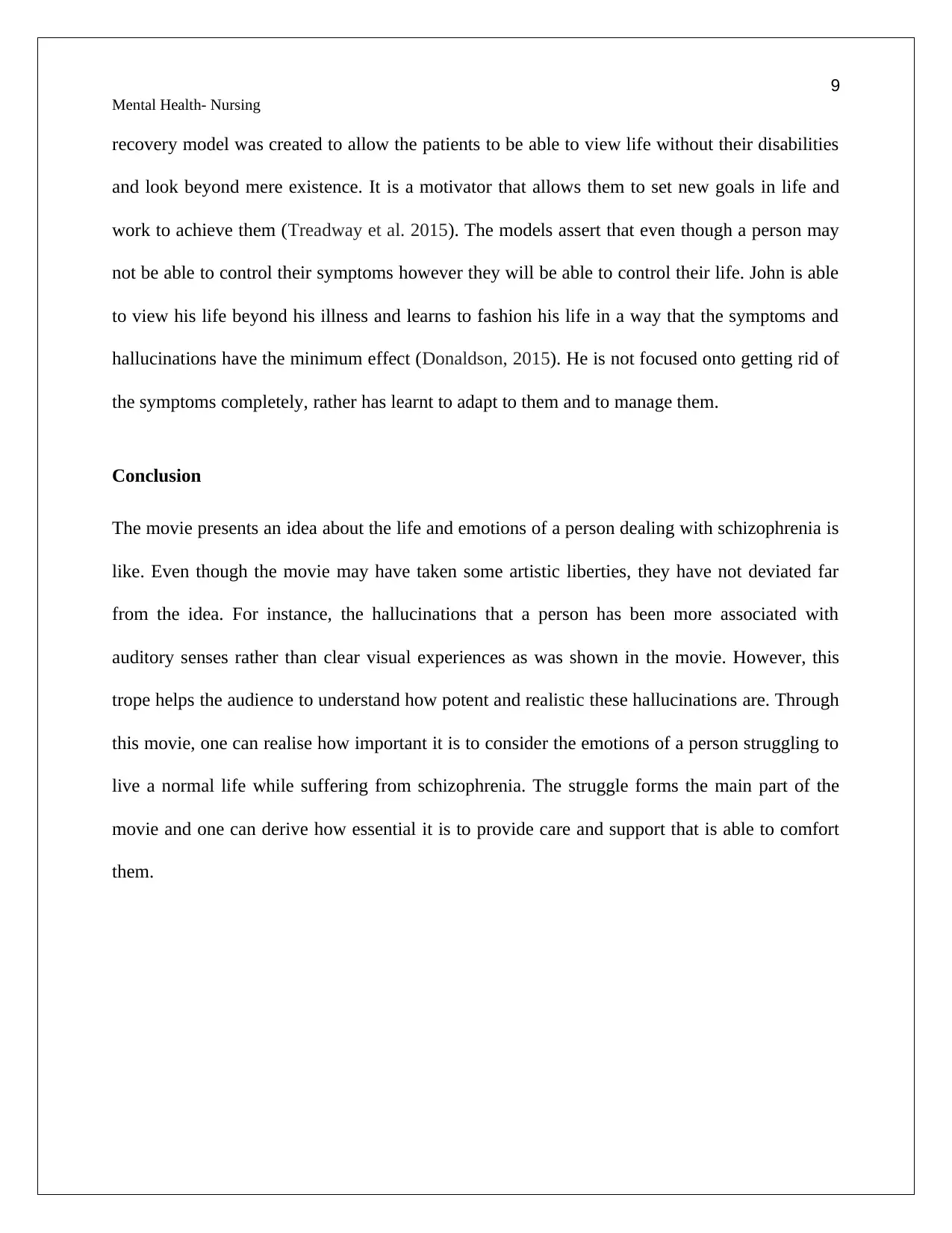
9
Mental Health- Nursing
recovery model was created to allow the patients to be able to view life without their disabilities
and look beyond mere existence. It is a motivator that allows them to set new goals in life and
work to achieve them (Treadway et al. 2015). The models assert that even though a person may
not be able to control their symptoms however they will be able to control their life. John is able
to view his life beyond his illness and learns to fashion his life in a way that the symptoms and
hallucinations have the minimum effect (Donaldson, 2015). He is not focused onto getting rid of
the symptoms completely, rather has learnt to adapt to them and to manage them.
Conclusion
The movie presents an idea about the life and emotions of a person dealing with schizophrenia is
like. Even though the movie may have taken some artistic liberties, they have not deviated far
from the idea. For instance, the hallucinations that a person has been more associated with
auditory senses rather than clear visual experiences as was shown in the movie. However, this
trope helps the audience to understand how potent and realistic these hallucinations are. Through
this movie, one can realise how important it is to consider the emotions of a person struggling to
live a normal life while suffering from schizophrenia. The struggle forms the main part of the
movie and one can derive how essential it is to provide care and support that is able to comfort
them.
Mental Health- Nursing
recovery model was created to allow the patients to be able to view life without their disabilities
and look beyond mere existence. It is a motivator that allows them to set new goals in life and
work to achieve them (Treadway et al. 2015). The models assert that even though a person may
not be able to control their symptoms however they will be able to control their life. John is able
to view his life beyond his illness and learns to fashion his life in a way that the symptoms and
hallucinations have the minimum effect (Donaldson, 2015). He is not focused onto getting rid of
the symptoms completely, rather has learnt to adapt to them and to manage them.
Conclusion
The movie presents an idea about the life and emotions of a person dealing with schizophrenia is
like. Even though the movie may have taken some artistic liberties, they have not deviated far
from the idea. For instance, the hallucinations that a person has been more associated with
auditory senses rather than clear visual experiences as was shown in the movie. However, this
trope helps the audience to understand how potent and realistic these hallucinations are. Through
this movie, one can realise how important it is to consider the emotions of a person struggling to
live a normal life while suffering from schizophrenia. The struggle forms the main part of the
movie and one can derive how essential it is to provide care and support that is able to comfort
them.
Paraphrase This Document
Need a fresh take? Get an instant paraphrase of this document with our AI Paraphraser

10
Mental Health- Nursing
References
Billeke, P., Armijo, A., Castillo, D., López, T., Zamorano, F., Cosmelli, D., & Aboitiz, F. (2015).
Paradoxical expectation: oscillatory brain activity reveals social interaction impairment in
schizophrenia. Biological psychiatry, 78(6), 421-431.
Casarrubea, M., Jonsson, G. K., Faulisi, F., Sorbera, F., Di Giovanni, G., Benigno, A., ... &
Magnusson, M. S. (2015). T-pattern analysis for the study of temporal structure of animal
and human behavior: a comprehensive review. Journal of neuroscience methods, 239, 34-
46.
Chyzhyk, D., Savio, A., & Graña, M. (2015). Computer aided diagnosis of schizophrenia on
resting state fMRI data by ensembles of ELM. Neural Networks, 68, 23-33.
Dollfus, S., & Lyne, J. (2017). Negative symptoms: history of the concept and their position in
diagnosis of schizophrenia. Schizophrenia research, 186, 3-7.
Donaldson, E. J. (2015). Beyond a beautiful mind: Schizophrenia and bioethics in the classroom.
Disability Studies Quarterly, 35(2).
Firth, J., Cotter, J., Elliott, R., French, P., & Yung, A. R. (2015). A systematic review and meta-
analysis of exercise interventions in schizophrenia patients. Psychological medicine,
45(7), 1343-1361.
Geretsegger, M., Mössler, K. A., Bieleninik, Ł., Chen, X. J., Heldal, T. O., & Gold, C. (2017).
Music therapy for people with schizophrenia and schizophrenia‐like disorders. Cochrane
Database of Systematic Reviews, (5).
Green, H. (2018). Why does the diagnosis of schizophrenia persist?. Philosophy, Psychiatry, &
Psychology, 25(3), 197-207.
Mental Health- Nursing
References
Billeke, P., Armijo, A., Castillo, D., López, T., Zamorano, F., Cosmelli, D., & Aboitiz, F. (2015).
Paradoxical expectation: oscillatory brain activity reveals social interaction impairment in
schizophrenia. Biological psychiatry, 78(6), 421-431.
Casarrubea, M., Jonsson, G. K., Faulisi, F., Sorbera, F., Di Giovanni, G., Benigno, A., ... &
Magnusson, M. S. (2015). T-pattern analysis for the study of temporal structure of animal
and human behavior: a comprehensive review. Journal of neuroscience methods, 239, 34-
46.
Chyzhyk, D., Savio, A., & Graña, M. (2015). Computer aided diagnosis of schizophrenia on
resting state fMRI data by ensembles of ELM. Neural Networks, 68, 23-33.
Dollfus, S., & Lyne, J. (2017). Negative symptoms: history of the concept and their position in
diagnosis of schizophrenia. Schizophrenia research, 186, 3-7.
Donaldson, E. J. (2015). Beyond a beautiful mind: Schizophrenia and bioethics in the classroom.
Disability Studies Quarterly, 35(2).
Firth, J., Cotter, J., Elliott, R., French, P., & Yung, A. R. (2015). A systematic review and meta-
analysis of exercise interventions in schizophrenia patients. Psychological medicine,
45(7), 1343-1361.
Geretsegger, M., Mössler, K. A., Bieleninik, Ł., Chen, X. J., Heldal, T. O., & Gold, C. (2017).
Music therapy for people with schizophrenia and schizophrenia‐like disorders. Cochrane
Database of Systematic Reviews, (5).
Green, H. (2018). Why does the diagnosis of schizophrenia persist?. Philosophy, Psychiatry, &
Psychology, 25(3), 197-207.

11
Mental Health- Nursing
Hankir, A., Holloway, D., Agius, M., & Zaman, R. (2015). Beyond a beautiful mind: film as an
educational and therapeutic tool. European Psychiatry, 30, 1901.
Koutsouleris, N., Meisenzahl, E. M., Borgwardt, S., Riecher-Rössler, A., Frodl, T., Kambeitz,
J., ... & Davatzikos, C. (2015). Individualized differential diagnosis of schizophrenia and
mood disorders using neuroanatomical biomarkers. Brain, 138(7), 2059-2073.
Mancini, M., & Stanghellini, G. (2016). Differential diagnosis between schizophrenia and in
major depression: The importance of abnormal bodily phenomena. European Psychiatry,
33, S663.
Meehl, P. E. (2017). Schizotaxia, schizotypy, schizophrenia. In Schizophrenia (pp. 21-46).
Abingdon: Routledge.
Moncrieff, J., & Middleton, H. (2015). Schizophrenia: a critical psychiatry perspective. Current
Opinion in Psychiatry, 28(3), 264-268.
Ranzcp, (2015), Involuntary commitment and treatment (ICT) criteria in Australian and New
Zealand Mental Health Acts, Retrieved from
https://www.ranzcp.org/files/resources/college_statements/mental-health-legislation-
tables/1-involuntary-commitment-and-treatment-comparing-m.aspx
Sheffield, J. M., & Barch, D. M. (2016). Cognition and resting-state functional connectivity in
schizophrenia. Neuroscience & Biobehavioral Reviews, 61, 108-120.
Treadway, M. T., Peterman, J. S., Zald, D. H., & Park, S. (2015). Impaired effort allocation in
patients with schizophrenia. Schizophrenia research, 161(2-3), 382-385.
Yang, A. C., Hong, C. J., Liou, Y. J., Huang, K. L., Huang, C. C., Liu, M. E., ... & Tsai, S. J.
(2015). Decreased resting‐state brain activity complexity in schizophrenia characterized
by both increased regularity and randomness. Human brain mapping, 36(6), 2174-2186.
Mental Health- Nursing
Hankir, A., Holloway, D., Agius, M., & Zaman, R. (2015). Beyond a beautiful mind: film as an
educational and therapeutic tool. European Psychiatry, 30, 1901.
Koutsouleris, N., Meisenzahl, E. M., Borgwardt, S., Riecher-Rössler, A., Frodl, T., Kambeitz,
J., ... & Davatzikos, C. (2015). Individualized differential diagnosis of schizophrenia and
mood disorders using neuroanatomical biomarkers. Brain, 138(7), 2059-2073.
Mancini, M., & Stanghellini, G. (2016). Differential diagnosis between schizophrenia and in
major depression: The importance of abnormal bodily phenomena. European Psychiatry,
33, S663.
Meehl, P. E. (2017). Schizotaxia, schizotypy, schizophrenia. In Schizophrenia (pp. 21-46).
Abingdon: Routledge.
Moncrieff, J., & Middleton, H. (2015). Schizophrenia: a critical psychiatry perspective. Current
Opinion in Psychiatry, 28(3), 264-268.
Ranzcp, (2015), Involuntary commitment and treatment (ICT) criteria in Australian and New
Zealand Mental Health Acts, Retrieved from
https://www.ranzcp.org/files/resources/college_statements/mental-health-legislation-
tables/1-involuntary-commitment-and-treatment-comparing-m.aspx
Sheffield, J. M., & Barch, D. M. (2016). Cognition and resting-state functional connectivity in
schizophrenia. Neuroscience & Biobehavioral Reviews, 61, 108-120.
Treadway, M. T., Peterman, J. S., Zald, D. H., & Park, S. (2015). Impaired effort allocation in
patients with schizophrenia. Schizophrenia research, 161(2-3), 382-385.
Yang, A. C., Hong, C. J., Liou, Y. J., Huang, K. L., Huang, C. C., Liu, M. E., ... & Tsai, S. J.
(2015). Decreased resting‐state brain activity complexity in schizophrenia characterized
by both increased regularity and randomness. Human brain mapping, 36(6), 2174-2186.
⊘ This is a preview!⊘
Do you want full access?
Subscribe today to unlock all pages.

Trusted by 1+ million students worldwide
1 out of 12
Related Documents
Your All-in-One AI-Powered Toolkit for Academic Success.
+13062052269
info@desklib.com
Available 24*7 on WhatsApp / Email
![[object Object]](/_next/static/media/star-bottom.7253800d.svg)
Unlock your academic potential
Copyright © 2020–2025 A2Z Services. All Rights Reserved. Developed and managed by ZUCOL.





